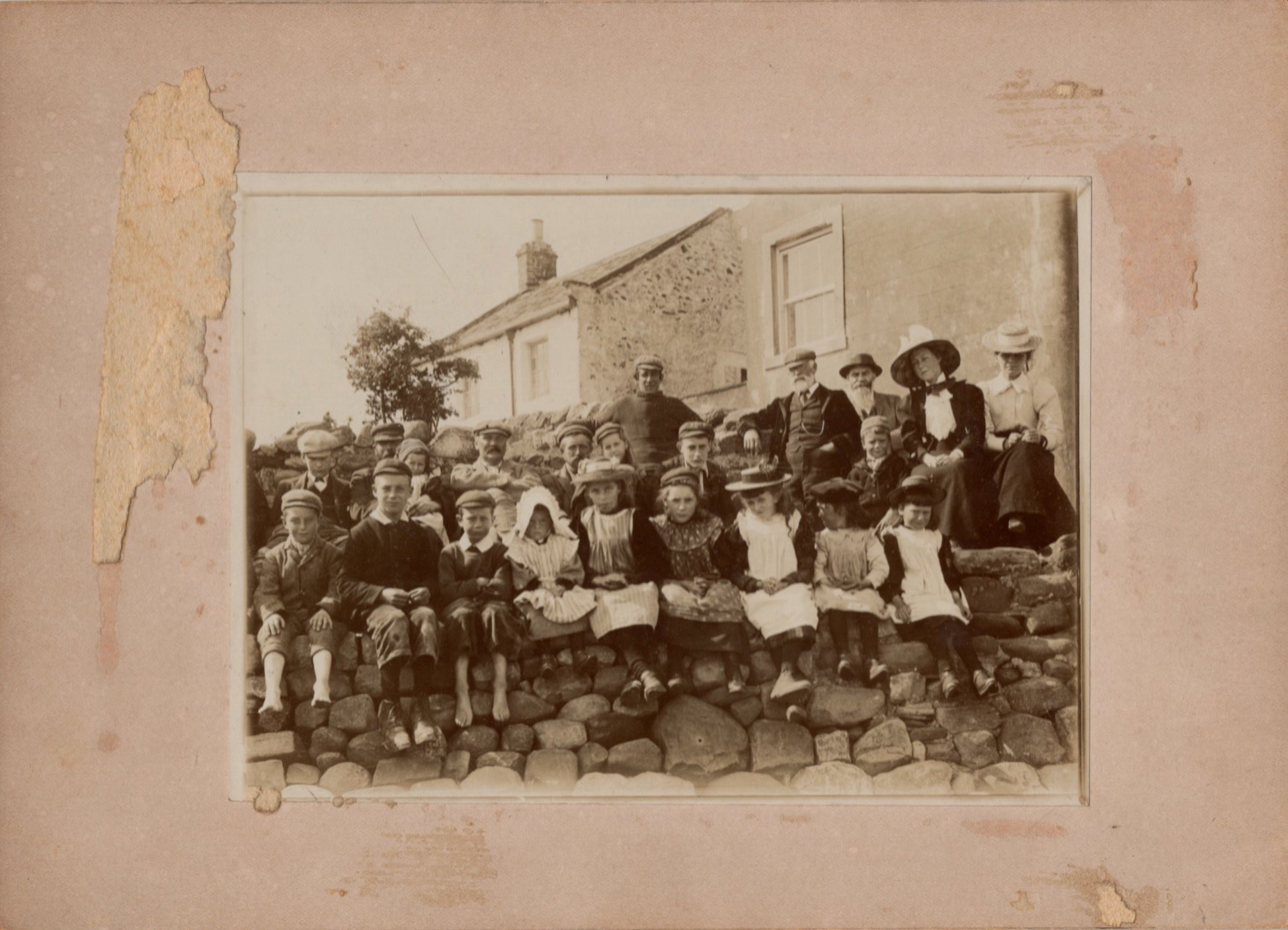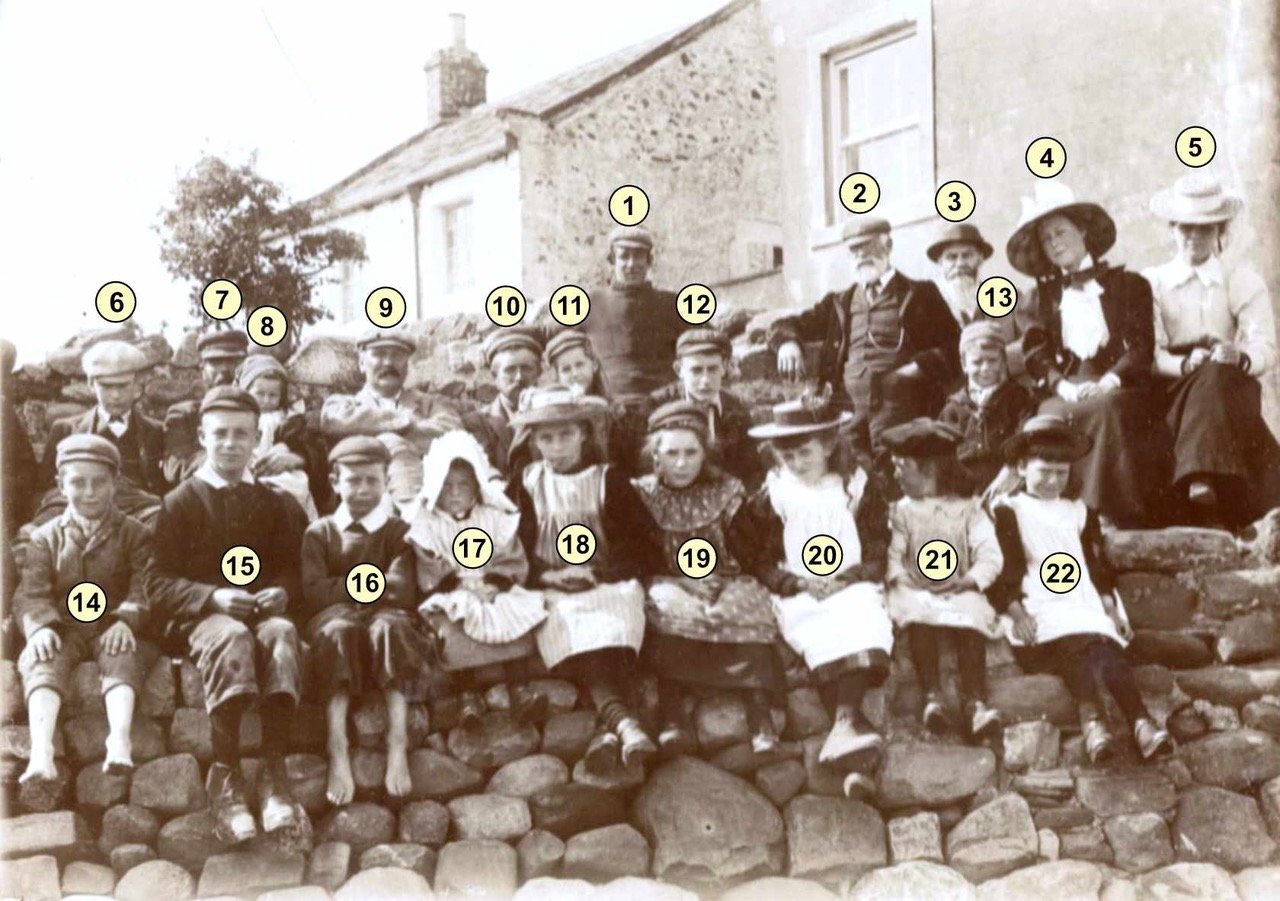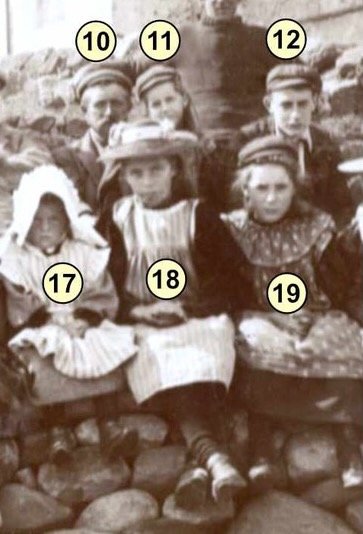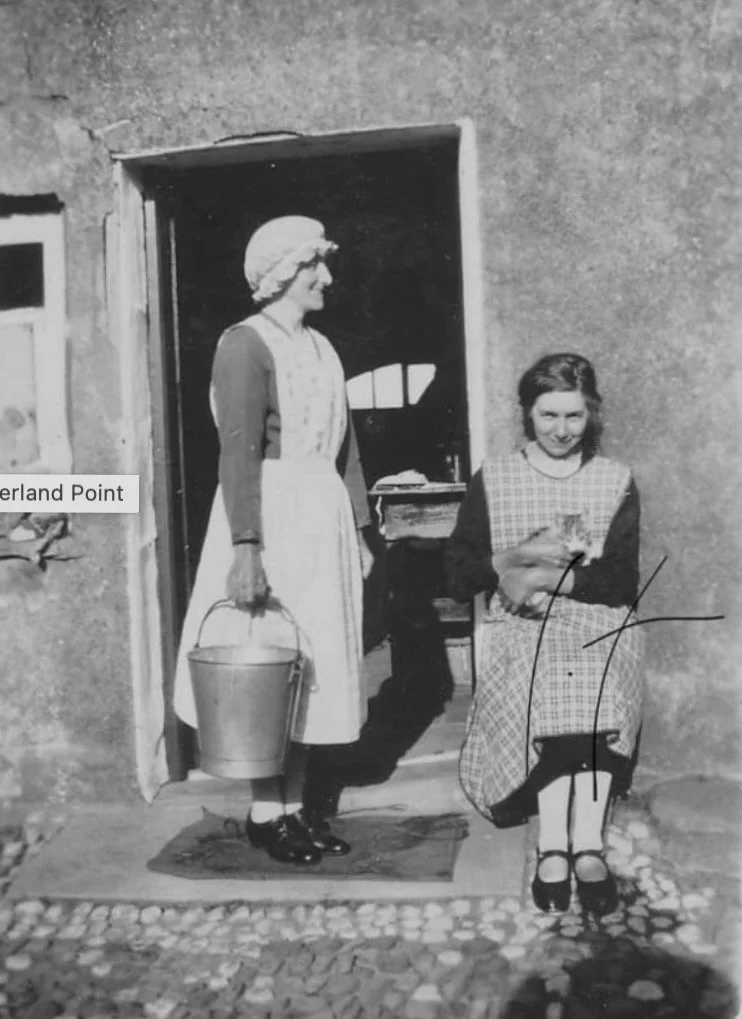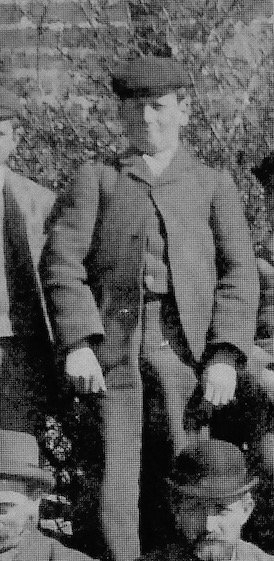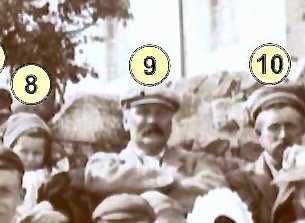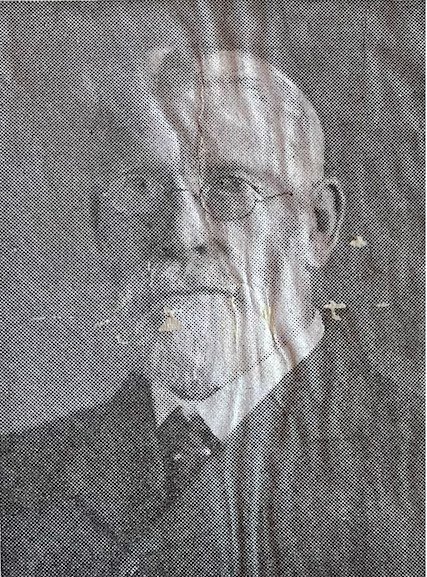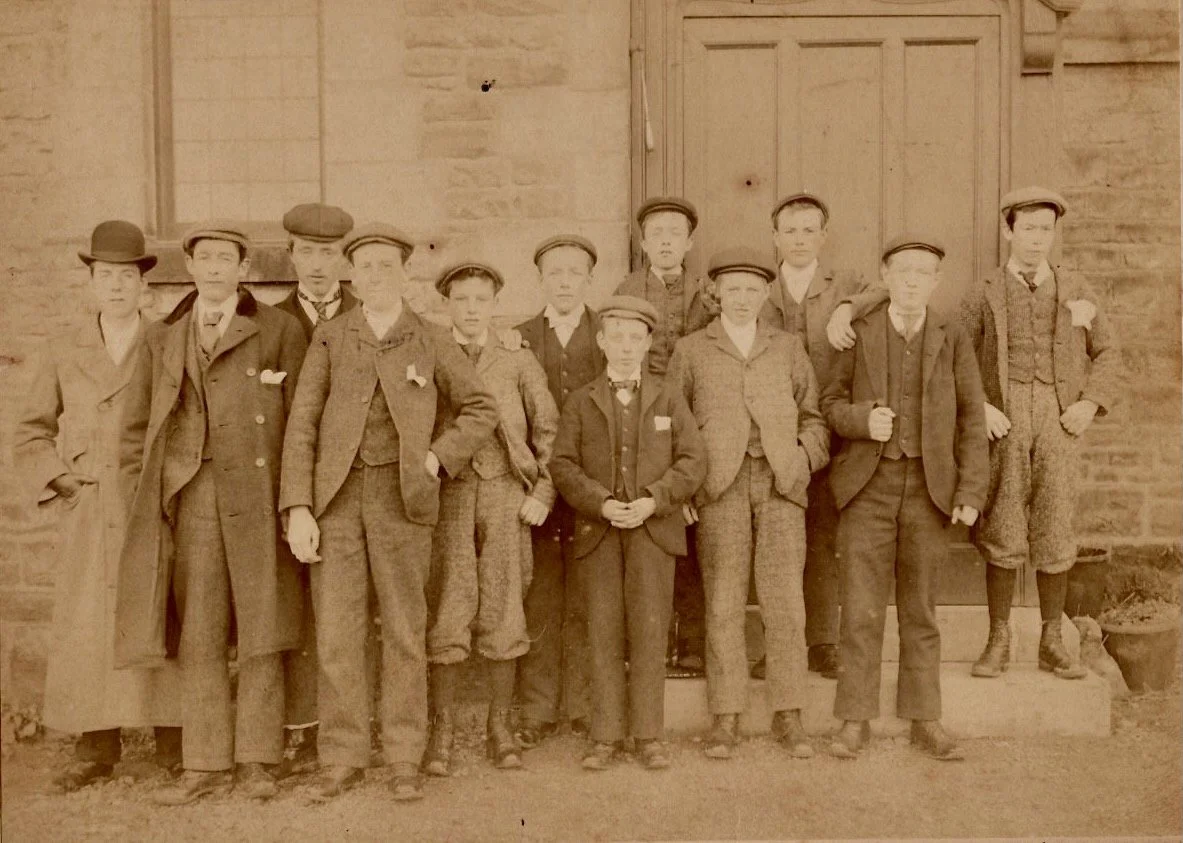The ‘Sunday School’ Photo
Group photograph from the collection of Harold Gardner
Among the many treasures in Harold Gardner’s collection of photographs and newspaper cuttings is this fascinating image of adults and (mainly) children. The image has been mounted and was probably once framed under glass, maybe belonging to Harold’s parents, perhaps cherished.
It is an important Sunderland Point photograph. The number of children alone makes it unusual, especially seeing so many girls. But there is much more than that here, it’s a moment in time that speaks from the 1890s.
Similar to all the oldest SP photographs, is the absence of women, whilst that’s not quite true here, we see young children and infants from the fishing families - but no mothers.
At first glance, it is difficult to place where it was taken, it’s the end of the pad as it leads onto First Terrace - where the mounting step is - looking up from the shore. In the background, the building on the centre-left is Upsteps Cottage, and number 11 is on the right.
This modern photo below, with the gate open to Dolphin House, confirms the location today.
Modern Photo: Bill
Harold did his best to identify who is who in the photograph. He knew most of those present, as well as seeing his aunts and uncles, his mother is also pictured.
There is a working paper with two lists of similar names, suggesting one early attempt and the second, Harold’s final considered list.
By following his guidance, checking dates and ages, and talking with today’s descendants of these families, it is possible to confirm the names of all but one (frustratingly).
And to give a date, 1896. The year is the clue to what is going on and why.
The children are obviously in their Sunday best, and, as this is perhaps 18 months after the opening of the Mission Church, this photograph may well be the first record of an early meeting of a Sunday school at the Mission Church.
So, who are they?
Here’s the photographs again edited to maximise clarity with numbers added for identification.
Following Harold’s numbering system, they are, 1. James W. Gardner, 2. Robert Mansergh, 3. William Swainson, 4. Dora Gilchrist, 5. Beatrice Swainson, 6. Robert Gardner, 7. R.W.B. Gardner, 8. Mary Ann Gardner, 9. A.H. Mansergh, 10. George Mason, 11. Nellie Mason, 12. Wilton Gardner, 13. Hubert Townley, 14. Unknown, 15. Jim Spencer, 16. Fred Spencer, 17. Jessie Townley, 18. Annie Townley, 19. Susie Mason, 20. Phoebe Townley, 21. Belle Gardner, and 22. Clarice Townley.
The families
The names confirm family kinship, most of the children are brothers and sisters and cousins. The Gardner family is the most numerous.
Richard W. B. Gardner (7) is here with his sons James W. (1), Wilton (12), Robert (6) and his daughter Belle (21). In his lap at just two years old is daughter Mary Ann (8), who would be known as Polly.
The family had recently moved from 3A into number 9 bought for £200 from Robert Mansergh, also seen here (2).
In this extra photo below, (dated slightly later) we can meet Richard’s wife Ann with five (of their six) daughters. Clockwise from the top, Elizabeth Mary, Belle, Eliza, and Bertha with Mary Ann in her lap.
Ann Gardner and daughters c1898: Courtesy the Gardner family.
In this detail is James Spencer (15) and his brother Fred (16), who live in the newly built semi in the Lane (now number 3) with parents Tom and Elizabeth Spencer. Sisters Agnes and Florence are not present, nor was three-year-old brother Walter who was to tragically drown in the Coppy pit the following year.
Fred is sitting next to Jessie Townley (17) whose bonnet almost covers her face, she is two- and a-bit years old. Next to her is sister Annie (18). They are the daughters of Arthur and Mary Townley who were living in number 17 on Second Terrace. They will shortly move into the Lane (to number 4).
At the end of the row are three more Townley children, the cousins of Annie and Jessie. These are the children of William and Bessie Townley, and are, Phoebe (20), Clarice (22), and sitting above is five-year-old Hubert (13). Clarice, who married Tom Gardner in 1920, was Harold’s mother.
This Townley family was living in the other semi in the Lane next door to Tom and Elizabeth Spencer. They would eventually move into number 6 First Terrace; Phoebe would live next door at number 5.
The little girl (21) is again Belle Gardner, six years old, looking around to see if younger sister Mary Ann is happy sitting on their father’s lap.
Just moved into number 11, then known as the Temperance Hotel are George Mason (10) and his two daughters Nellie (11) and Susie (19) shortened names for Ellen and Susannah. George, his wife Elizabeth, and their daughters would spend the rest of their lives on the Point. In the right image, taken some 40 years later, are Susie and Nellie (seated), at the rear of number 11.
That accounts for the children – apart from stubbornly mysterious child 14.
Harold thought it might have been Gerard Bagot, but it isn’t. Here they are placed side by side, Gerard’s image comes from a photo taken two years earlier, by 1896 he would have been 13, and he was famously, like his father, a big person. Does anybody know who number 14 might be?
The Adults
Of the other adults, Arthur Mansergh (9), at this time aged 29 is easily identifiable, he is well known through his sailing boat Sue and his gift to the village of ‘the seat at the top of the Lane’. He will have been spending the summer with family at the recently built number 3.
They are, Robert Mansergh (2), who is Arthur’s father, William Swainson (3), Dora Gilchrist (4), and Beatrice Swainson (5). All four were summer visitors, Robert at number 3, William and his daughter Beatrice at number 22, and Dora with other members of the Gilchrist family in the Old Hall, number 21.
Dora would become daughter-in-law to William when she married his son William G. Swainson in 1908.
Beatrice, a talented artist, remained single and lived with her father until his death in 1928 aged 87.
The presence of these two men is convincing evidence this is a Sunday school.
Both men exerted considerable influence at Sunderland Point, they were professionally successful and highly respected public figures in Lancaster and wider afield. They both held deep religious convictions and believed strongly in the Christian education of children. Both were staunch advocates and activists in support of temperance (total abstinence from alcohol).
‘Train up a child in the way he should go, and when he is old, he will not depart from it’ (Proverbs 22:6)
William Swainson 1841-1928: From the collection of the Gilchrist family
Robert Mansergh and William Swainson
Robert Mansergh was the son of John Birkett Mansergh who with another family member inherited property at Sunderland Point in the 1840s. John Birkett Mansergh installed the bay windows into number 9 and Robert built number 3 ‘The Moorings’ in the early 1890s.
Robert was a life-long member of the Congregational church, holding key positions within the church organisation in Lancashire. During his life he was a parish councillor, an independent (Liberal leaning) member of Lancaster Town Council and later, chairman of the Lancaster Rural District Council. He was a Port commissioner and a member of the Lune fisheries board.
He was also a founding member of the Lancaster and Morecambe branch of the international Institute of Good Templars dedicated to temperance. He was chairman of the Lancaster Total Abstinence Society. The president was William Swainson.
They were also both members of the Lancaster School Attendance Committee (set up in 1877 to ensure children attended school), William Swainson was its secretary.
William was for many years secretary of the Lancaster branch of the British and Foreign Bible Society and a supporter of the Church Missionary Society. Perhaps most importantly, he was president and sometimes chairman of the Lancaster and District Sunday School Union.
William was also a founder trustee of the Mission Church.
Perhaps it would have been a matter of duty and religious obligation for these two men to support the inauguration of a Sunday school after the building of the Mission Church.
Inside of the Mission Church as the children would have known it c1900: From the collection of Wilton Atkinson.
What was it like – the Sunday school?
Almost all children went to Sunday schools in the 1890s, this was almost the high-water mark of Sunday school attendance in England and Wales. The Sunday school movement was a century old, founded to reach the children of working-class families to provide a religious education including the ability to read the bible.
It’s difficult to imagine what it was really like attending a Sunday school on the Point, but it is most unlikely to have been fun, more probably, formal, serious, and disciplined.
There would be prayers at the beginning and at the finish. Bible study would be a core subject, even for the very youngest. If Dora Gilchrist took part, perhaps there was hymn singing. Dora was an accomplished pianist and would become a regular player of the harmonium in the Mission Church until it finally broke beyond repair in the late 1960s.
Older children would be assisted in learning the catechism in preparation for confirmation classes in Overton. It’s even possible these children will have been warned of the vice of alcohol consumption.
Confirmation Class
This rather faded photograph, taken in 1898, two years after the Sunday school photograph is of the confirmation class in Overton. Four are from the Point.
Overton confirmation class, Easter 1898: From the collection of Wilton Atkinson
Second from the left is James W. Gardner (wearing the splendid coat), third from left and behind is Thomas Hargreaves from Sunderland Brows Farm, fourth is Gerard Bagot and at the end, right, is James’s brother Wilton Gardner.
James is aged 18, Wilton, Gerard and Thomas were all sixteen.
There will have been attendance at Sunday schools before the opening on the Mission Church and for many years they were a weekly event at the Point before coming to a final end in the late 1980s. Perhaps we can look at a full story their history another time.
Many thanks to Rosemary Lawn for permitting the use of Harold’s photograph, Elizabeth Gilchrist for identifying family members and the Gardner family for confirming their relatives, also to Paul Hatton who numbered the photos. Special thanks to Kris Needham who diligently checked the census records and other photographs to confirm names, the date, and the ages of those present.
